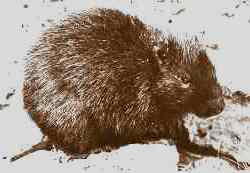Dwarf hatias
| Dwarf hatias | ||||||||||||
|---|---|---|---|---|---|---|---|---|---|---|---|---|

The Cabrera tree rat ( Mesocapromys angelcabrerai ) also belongs to the genus of the dwarf hatias |
||||||||||||
| Systematics | ||||||||||||
|
||||||||||||
| Scientific name | ||||||||||||
| Mesocapromys | ||||||||||||
| Varona , 1970 |
The dwarf hatias ( Mesocapromys ) are a genus of rodents from the subfamily of the tree rats (Capromyinae). The four species of these genera that are still alive today live on Cuba and offshore islands and are threatened with extinction.
General
Dwarf hatias are similar to the Hutiaconga and were previously classified in the same genus ( Capromys ), but they are much smaller. They reach a head body length of 21 to 30 centimeters and a tail length of 18 to 21 centimeters. They resemble stubborn rats , their fur is dark brown or black in color.
Little is known about the way of life of these animals, their habitat are swamps and marshland.
Although the four species are protected, they are threatened by habitat destruction and by introduced house rats . All four species are listed as " critically endangered " by the IUCN .
species
- The Cabrera tree rat ( Mesocapromys angelcabrerai ) lives on the island of Cayos de Ana Maria off the south coast of Cuba and possibly on the adjacent mainland.
- The long-eared tree rat ( Mesocapromys auritus ) occurs only on the island of Cayo Fragoso off the north coast of Cuba.
- The dwarf tree rat ( Mesocapromys nanus ) lives on the Zapata peninsula in the Matanzas province . The animals themselves have not been sighted since the 1930s, but recent footprints and feces have been found that suggest the species may still be alive.
- The San Felipe tree rat ( Mesocapromys sanfelipensis ) is endemic to the island of Cayo Juan Garcia off the Cuban southwest coast.
A number of other species are only known from bone finds, they are all considered extinct. These include the gracilis and minimus muscles .
literature
- Ronald M. Nowak: Walker's Mammals of the World. 2 volumes. 6th edition. Johns Hopkins University Press, Baltimore MD et al. 1999, ISBN 0-8018-5789-9 .
Web links
- Endangerment level of the individual species in the IUCN Red List of Threatened Species .